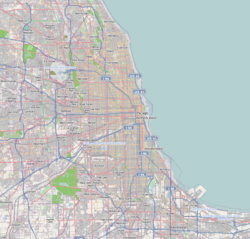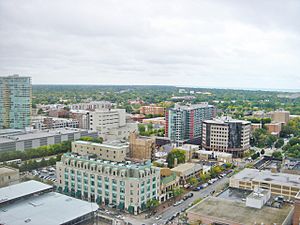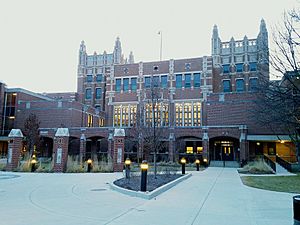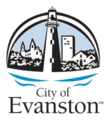Evanston, Illinois facts for kids
Quick facts for kids
Evanston, Illinois
|
|||||
|---|---|---|---|---|---|
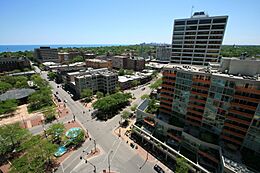
View of downtown, at Sherman Avenue and Davis Street, looking south/south-east toward Chicago
|
|||||
|
|||||
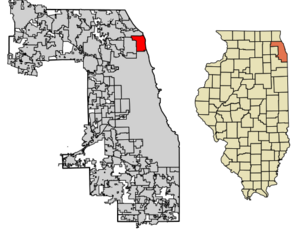
Location of Evanston in Cook County, Illinois
|
|||||
| Country | |||||
| State | |||||
| County | |||||
| Incorporated | 1863 | ||||
| Government | |||||
| • Type | Council–manager | ||||
| Area | |||||
| • Total | 7.80 sq mi (20.21 km2) | ||||
| • Land | 7.78 sq mi (20.15 km2) | ||||
| • Water | 0.02 sq mi (0.06 km2) 0.26% | ||||
| Population
(2020)
|
|||||
| • Total | 78,110 | ||||
| • Density | 10,041.14/sq mi (3,876.66/km2) | ||||
| 4.86% increase from 2010 | |||||
| Demonym(s) | Evanstonian | ||||
| Standard of living (2011) | |||||
| • Per capita income | $40,732 | ||||
| • Median home value | $340,700 | ||||
| Demographics (2010) | |||||
| • White | 65.6% | ||||
| ZIP Codes |
60201–60204, 60208–60209
|
||||
| Area codes | 847 & 224 | ||||
| FIPS code | 17-24582 | ||||
| GNIS ID | 2394709 | ||||
Evanston (pronounced EV-ən-stən) is a city in Cook County, Illinois, United States. It sits on the North Shore of Lake Michigan. Evanston is a suburb about 12 miles north of Downtown Chicago. It borders Chicago to the south, Skokie to the west, Wilmette to the north, and Lake Michigan to the east. In 2020, Evanston had a population of 78,110 people.
Methodist business leaders founded the city in 1857, and it officially became a city in 1863. Evanston is home to Northwestern University, a top research university founded in 1851. The city is known for its diverse population. Chicago and Northwestern University have greatly influenced Evanston over the years. The city and the university have a long and interesting relationship.
Contents
- Evanston's Story: A Look at Its History
- Evanston's Geography and Environment
- Who Lives in Evanston? A Look at Its People
- Evanston's Economy and Jobs
- Arts, Culture, and Fun in Evanston
- Education in Evanston
- Media and Filming in Evanston
- Getting Around: Transportation in Evanston
- Notable People from Evanston
- Evanston and Northwestern University
- Fun Nicknames for Evanston
- Images for kids
- See also
Evanston's Story: A Look at Its History
Before the 1830s, the area where Evanston now stands was mostly empty. It had many wetlands and swampy forests. However, Potawatomi Native Americans used trails along higher lands that ran north to south. They also had some small settlements there.
French explorers called the general area "Grosse Pointe." This name came from a piece of land that stuck out into Lake Michigan. It was about 13 miles north of the Chicago River. The first non-Native Americans settled here in 1836. For many years, people used names like "Grosse Point Territory" for the area. But it didn't have clear borders. The area remained mostly unsettled, with some farming and logging. There were also a few inns along the main roads.
In 1850, a township called Ridgeville was created. It stretched from Chicago to what is now Central Street. It also went from Lake Michigan to Western Avenue in Chicago. The 1850 census showed a few hundred settlers in this township. A post office named Ridgeville was set up at one of the inns. But there was no official city yet.
Founding Northwestern University
In 1851, a group of Methodist business leaders started Northwestern University. They also founded Garrett Biblical Institute. They chose a beautiful, wooded spot along the lake for Northwestern's home. They bought hundreds of acres of land from a farmer named John Foster. In 1854, the founders asked the county to create a city. They wanted to name it Evanston after John Evans, one of their leaders. Their request was approved in 1857.
The township of Evanston was then separated from Ridgeville Township. Around the same time, the southern part of Ridgeville became Lake View Township.
Becoming a City
Evanston officially became a town on December 29, 1863. But it turned down the chance to become a city in 1869. After the Civil War, Evanston grew by adding the village of North Evanston. Finally, in early 1892, after adding the village of South Evanston, voters chose to become a city. The city's borders from 1892 are mostly the same today.
In 1939, Evanston hosted the first ever NCAA basketball championship final. This exciting event took place at Northwestern University's Patten Gymnasium.
In August 1954, Evanston hosted the second meeting of the World Council of Churches. This was the only time this group met in the United States. President Dwight Eisenhower welcomed the visitors. The Secretary-General of the United Nations, Dag Hammarskjöld, gave an important speech.
Evanston first received electricity in April 1893. Many people gathered on Emerson Street to see the first streetlights turn on. Today, Evanston is home to Northwestern University and the Music Institute of Chicago. It also hosts the headquarters of Rotary International and the National Merit Scholarship Corporation.
Evanston is where Tinkertoys were invented. It is also one of the places that claims to have created the ice cream sundae.
Changes in Alcohol Laws
Evanston was a "dry community" from 1858 until 1972. This meant that selling alcohol was not allowed. In 1972, the City Council voted to let restaurants and hotels serve alcohol. In 1984, they allowed stores to sell alcohol within the city limits.
Modern Initiatives
In March 2021, Evanston made history. It became the first city in the United States to pay reparations. These payments went to African American residents (or their families) who were treated unfairly in housing. The city council approved payments of $25,000 to African American households. This money could be used for down payments on homes, house payments, or home repairs. This was the first step in a plan to give $10 million in reparations over ten years.
In August 2021, Evanston was also one of the first cities to try a new project. It approved a pilot program to give a guaranteed income to some residents. This project uses both public money and help from Northwestern University.
Evanston's Geography and Environment
Evanston covers about 7.80 square miles (20.21 square kilometers). Most of this area is land, with a small amount of water.
Working for a Greener City
In October 2006, Evanston decided to join the United States Conference of Mayors Climate Protection Agreement. This meant the city would work to reduce its impact on the environment. Many citizen groups helped create the Evanston Climate Action Plan ("ECAP"). The City Council approved this plan in November 2008.
The ECAP suggested over 200 ways to make Evanston more sustainable. This included reducing carbon emissions from transportation, buildings, energy, waste, and food. In June 2011, Evanston won first place in a national award for its climate protection efforts. The city says the ECAP has reduced emissions by 24,000 metric tons each year.
Who Lives in Evanston? A Look at Its People
| Historical population | |||
|---|---|---|---|
| Census | Pop. | %± | |
| 1880 | 4,400 | — | |
| 1890 | 9,000 | 104.5% | |
| 1900 | 19,259 | 114.0% | |
| 1910 | 24,978 | 29.7% | |
| 1920 | 37,234 | 49.1% | |
| 1930 | 63,338 | 70.1% | |
| 1940 | 65,389 | 3.2% | |
| 1950 | 73,641 | 12.6% | |
| 1960 | 79,263 | 7.6% | |
| 1970 | 79,808 | 0.7% | |
| 1980 | 73,706 | −7.6% | |
| 1990 | 73,233 | −0.6% | |
| 2000 | 74,239 | 1.4% | |
| 2010 | 74,486 | 0.3% | |
| 2020 | 78,110 | 4.9% | |
| U.S. Decennial Census 2010 2020 |
|||
Population in 2020
In 2020, Evanston had 78,110 people living in 27,918 households. About 15,184 of these were families. The city's population density was about 10,013 people per square mile. There were 34,462 housing units in total.
The racial makeup of the city was:
- 59.06% White
- 16.06% African American
- 9.92% Asian
- 11.24% Hispanic or Latino (of any race)
- The rest were Native American, Pacific Islander, or from two or more races.
About 19.9% of the population was under 18 years old. The average age in the city was 36.2 years. The median income for a household was $82,335. For a family, it was $130,494. About 11.7% of the population lived below the poverty line.
Evanston's Economy and Jobs
In 2012, 12.3% of Evanston's businesses were owned by Black people. In 2017, 24% of the city's businesses with employees were owned by women.
Major Employers
Here are some of the biggest employers in Evanston:
- Northwestern University
- NorthShore University HealthSystem
- Evanston-Skokie School District 65
- Saint Francis Hospital
- City of Evanston
- Presbyterian Homes
- Rotary International
- Evanston Township High School District 202
- Jewel/Osco
- C.E. Niehoff & Co.
Other Important Businesses
- Magnetar Capital, a company that manages investments.
- ZS Associates, a consulting company.
- Clayton Mark and Company, a steel product maker.
- Legacy.com, a website for online memorials.
Arts, Culture, and Fun in Evanston
Places to Visit
- Evanston Art Center
- Evanston Township High School
- Frances Willard House
- Free School of Evanston
- Grosse Point Lighthouse
- Harley Clarke Mansion
- Ladd Arboretum
- Lighthouse Beach
- Mount Trashmore
- North Shore Channel Trail
- Northwestern University
- Ryan Field
Shopping Areas
Evanston has several places to shop and eat:
- Downtown - This area is near the Davis Street Metra and "L" train stops. It has over 300 businesses, tall office and apartment buildings, and more than 85 restaurants.
- Central Street - This area has several shopping spots along the city's northern main street. It's known for its unique shops and restaurants, especially near the Central Street Metra station.
- Dempster Street - Close to the Dempster "L" train stop, with over 60 shops.
- Main Street - This area has about three blocks of independent shops and restaurants. It's near both a CTA and Metra stop.
- Howard Street - This street forms the southern border between Evanston and Chicago. The Howard Street CTA station is a major transfer point for different train and bus lines.
- Chicago Avenue - This is a main north-south road that connects the Main Street, Dempster Street, and Downtown shopping areas.
- Noyes - Near the Noyes "L" train stop, with several restaurants, dry cleaners, and convenience stores.
Evanston Public Library
The Evanston Public Library opened in 1873. It has a branch at the Robert Crown Community Center.
Education in Evanston
Public Schools
High School
Most of Evanston is part of Evanston Township High School District 202. The district has one high school, Evanston Township High School. It has over 4,000 students in grades 9 through 12.
Elementary and Middle Schools
Evanston-Skokie Community Consolidated School District 65 serves all of Evanston. It provides education from pre-kindergarten through 8th grade. The district has ten elementary schools (K-5), three middle schools (grades 6-8), two magnet schools (K-8), and other special schools.
Private Schools
Evanston has several private schools:
- Beacon Academy, a Montessori high school.
- Chiaravalle Montessori School, for children ages 2–14.
- Midwest Montessori School.
- Pope John XXIII School, a Catholic school for pre-kindergarten through eighth grade.
- Roycemore School.
- St. Athanasius School, a Catholic school for junior kindergarten through eighth grade.
Universities
Evanston is home to Northwestern University, founded in 1855. Northwestern's campus is along Lake Michigan. It covers 240 acres and has about 250 buildings. Since 1908, the Kellogg School of Management and Garrett-Evangelical Theological Seminary have also been part of the Northwestern campus.
Media and Filming in Evanston
Local Media
- The Daily Northwestern, the student newspaper at Northwestern University.
- The Evanstonian, the student newspaper at Evanston Township High School.
- The Evanston Review, a weekly newspaper.
- The Evanston RoundTable, a free online news site.
- The Evanston Sentinel, a free weekly African-American newspaper.
- Evanston Now, an online newspaper and community website.
Evanston on Screen: Film Locations
Evanston is a popular place for filming movies. This is because of its different types of homes and businesses, and its easy access to Chicago. Evanston has been a filming location for 65 different films. Many films by John Hughes were shot here.
Some notable movies filmed in or around Evanston include:
- Sixteen Candles (1984)
- She's Having a Baby (1988)
- Uncle Buck (1989)
- Dennis the Menace (1993)
- Home Alone 3 (1997)
Scenes from the 1986 film Nothing in Common were filmed at Northwestern University and along Evanston's lakefront. The 2004 film Mean Girls is set in the Chicago suburbs and mentions the area. The movie's writer, Tina Fey, once worked at the Evanston YMCA. In the 2003 film Cheaper by the Dozen, the family moves to Evanston. Part of the 1993 film Rookie of the Year was filmed at Haven Middle School. The 2015 reality show Becoming Us was also filmed in Evanston.
In The Princess Bride, the screenplay says the boy and his grandfather live in Evanston. The story's author, William Goldman, grew up near Evanston.
Getting Around: Transportation in Evanston
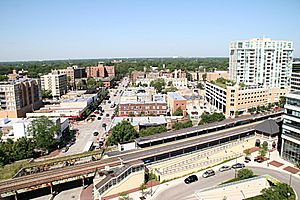
Evanston grew quickly because it was easy to reach from Chicago by train. The founders of Northwestern University made sure a railway line would run there before they chose the location. Trains started stopping in Evanston in 1855. Evanston later became one of the first "streetcar suburbs."
The city is still connected to Chicago by train. The CTA's Purple Line train runs through Evanston. It has several stops in the city, including South Boulevard, Main, Dempster, Davis, Foster, Noyes, and Central. The Metra's Union Pacific North Line also serves Evanston. It has stations at Main Street, Davis Street, and Central Street.
Evanston also has six CTA bus routes and four Pace bus routes. For cars, main routes from Chicago include Lake Shore Drive and the Edens Expressway (I-94). The city also has many sidewalks and bicycle lanes for walking and biking.
Notable People from Evanston
Evanston and Northwestern University
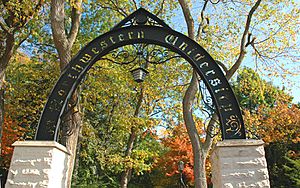
A common discussion in Evanston is about Northwestern University's tax-exempt status. When Northwestern University was founded in 1851, the state allowed it to not pay property taxes. Unlike some other wealthy private universities, Northwestern provides its own police services. However, it does pay for water, sewer, communications, and building permits. It does not pay property taxes for the land it owns.
Supporters of Northwestern, like former Evanston mayor Lorraine H. Morton, say that the benefits of having a top research university are worth its tax status. They point out that Northwestern University is the largest employer in Evanston. Its students and staff also spend a lot of money at local businesses. This topic came up again in 2003 when the university bought a large office building downtown. This removed the building from the city's tax rolls.
During Mayor Elizabeth Tisdahl's time in office, the relationship between the university and Evanston got better. When Morton O. Schapiro became Northwestern's president in 2009, he worked well with Mayor Tisdahl. In 2015, they announced that Northwestern would start donating $1 million each year to help city services and programs.
Fun Nicknames for Evanston
Evanston has had a few interesting nicknames over the years:
- "Heavenston" - Early on, because of its strong Methodist influence and strict moral rules, people sometimes called it "Heavenston."
- "The City of Churches" - In the early 1900s, it was known as "The City of Churches."
- "The City of Homes" - By the 1920s, because of its many beautiful houses and famous architects, it was called "The City of Homes." This phrase was often used by real estate agents.
- "The People's Republic of Evanston" - Since the late 1900s, because Evanston is known for its activism and often liberal politics, some people jokingly call it "The People's Republic of Evanston."
Images for kids
See also
 In Spanish: Evanston (Illinois) para niños
In Spanish: Evanston (Illinois) para niños





